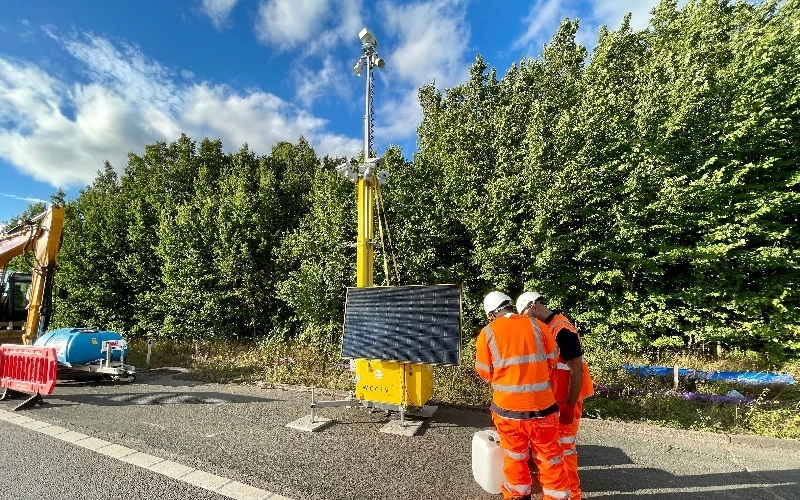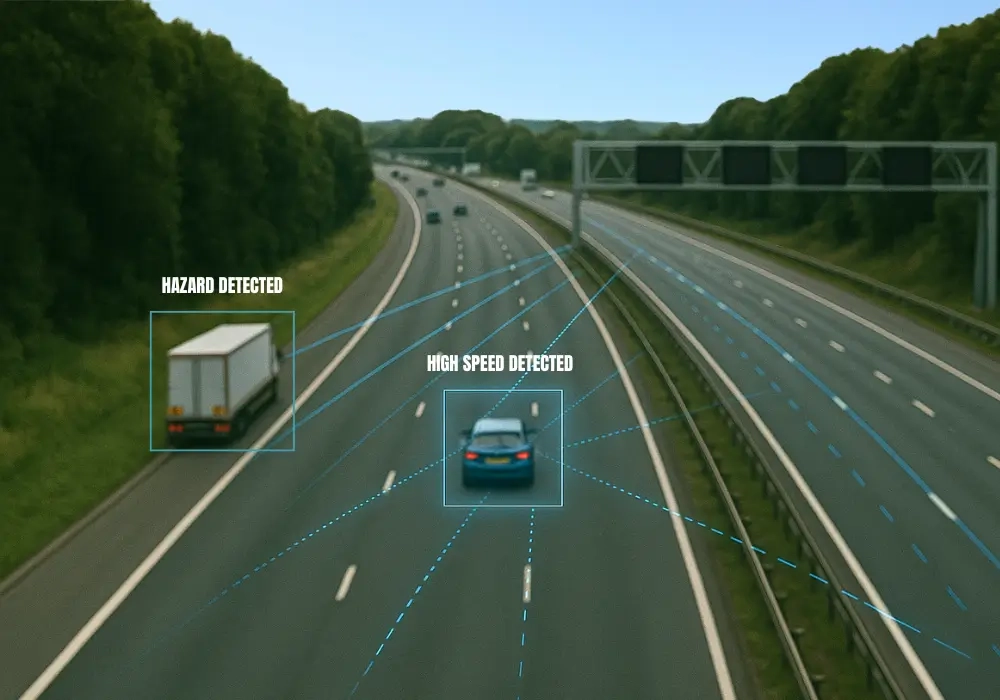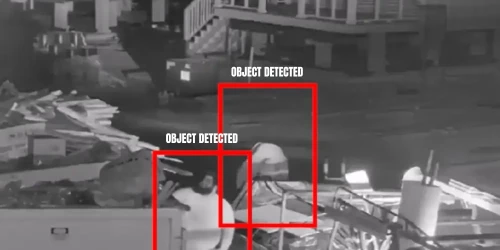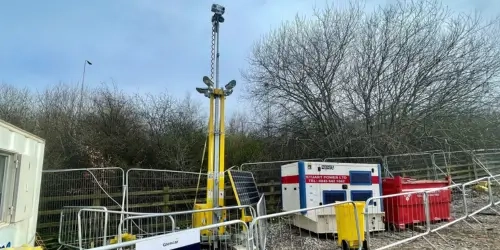Every day, the UK's strategic road network (SRN) carries millions of vehicles across thousands of miles of high-speed roads. Highways England manages 4,600 miles of motorways and major A-roads, facing constant pressure to maintain public safety while keeping traffic moving smoothly.
Although dangerous driving offences in England and Wales declined slightly to 4,858 in 2024, road risks still remain high. Speeding, distraction and poor weather continue to cause serious injuries and concerns, exposing the limits of traditional security systems that can only record events rather than prevent them.
This is where AI-powered monitoring solutions are starting to make a real difference.
In this guide, we'll explore how AI detection is transforming road safety in the UK, giving traffic management contractors, transport agencies and public sector stakeholders the ability to spot problems as they develop and respond before situations become dangerous.
How Effective are Traditional Security Systems on High-Speed Roads?
Traditional security systems fall short on high-speed roads for several reasons:
False alarms
Conventional motion detection systems often trigger false alarms from swaying vegetation, weather conditions and routine road activity. This overload can leave control room operators battling "alert fatigue" from processing multiple false alarms daily, reduce trust in the system and drain valuable response resources.
Artificial intelligence (AI) detection systems with advanced AI algorithms and pattern recognition can tell the difference between real threats and harmless activity. With sophisticated video analytics and machine learning, they monitor multiple lanes, vehicle types, road conditions and driving behaviours in real-time, cutting false alarms by as much as 85% compared to traditional security setups.
Delayed threat detection
Many traditional security systems just record footage or rely on staff to review it manually. Checking potential collision hotspots or incidents can take around 5-10 minutes, during which time a secondary accident might happen, further delaying emergency response. On high-speed roads, every second counts and these delays can have a real impact on road safety.
Smart road safety systems spot road accidents and incidents within seconds. When connected to NSI Gold Accredited monitoring centres, trained professionals assess the situation in real-time and coordinate mobile keyholding teams and emergency responses instantly. This rapid detection helps prevent delays and keep roads safer for everyone.
Resource inefficiency
Manned security guards can cost anywhere between £24,000 and £32,000 annually, putting a heavy strain on budgets without always delivering reliable results. Relying on human oversight alone also creates unsustainable demands for day-to-night highway coverage, leading to fatigue and reduced effectiveness over time.
AI-enhanced systems can cut security costs by 88% compared to manned monitoring. With our Stellifii platform, you get 24/7 remote monitoring that delivers greater accuracy and faster response times without the need for constant human oversight. You can view live and recorded footage, run full diagnostics and carry out health checks from any device anywhere, so your security never switches off.
Limited coverage
Traditional security setups generally rely on fixed cameras that cover just one angle, leaving blind spots and large stretches of highways unmonitored. These static installations can't adapt to changing traffic patterns and dynamic roads, nor provide full coverage across extensive road networks.
On top of this, many older systems only record footage and don't detect incidents or have real-time alert functions. This means road problems often go unnoticed until it's too late.
Systems with AI technology take traditional security to new heights. Equipped with high-definition PTZ (Pan-Tilt-Zoom) cameras, thermal imaging and night vision, they deliver near-360° coverage even in complete darkness, heavy rain, dust and fog. Intelligent software ensures data is stored securely, while bolt-on accessories like ANPR and Time Lapse Video personalise your security to your needs.
Power constraints
Traditional CCTV systems depend on mains power, fixed internet and permanent infrastructure to operate. This makes them vulnerable to power outages and difficult to deploy on remote roads. There's also the added risk of metal theft. Criminals and organised crime groups often target copper cabling due to its scrap value, leaving roads unmonitored for days or weeks before anyone notices.
AI-powered security solutions don't rely on mains electricity, fixed broadband or permanent infrastructure, making them ideal for even the most remote locations. Powered entirely by solar energy, these self-contained systems deliver uninterrupted surveillance for up to 20 weeks between charges. Their autonomous design helps to protect vulnerable road users, cyclists, pedestrians and roadwork construction teams both day and night.
Read more:
- Why Traditional Security Fails on High‑Speed Roadworks (And What Works Instead)
- How Artificial Intelligence is Revolutionising CCTV Tower Monitoring
4 AI Detection Myths Debunked
Let's debunk 4 common myths about CCTV Towers equipped with AI technology:
Myth #1: AI systems are unreliable due to power constraints
Many people assume AI detection systems are unreliable because highway authorities have experienced monitoring disruptions from power outages or lost internet connections. In remote motorway locations, where fixed infrastructure is often limited, there’s a common concern that advanced systems might fail.
Debunked: AI systems operate autonomously with in-built diagnostics.
Today's AI-powered CCTV Towers operate completely independently of mains power and fixed broadband. Our Traffic Management Towers run on solar energy and fuel cell batteries for up to 20 weeks and use secure 4G/5G networks to transmit data. Additionally, our in-built Heartbeat software monitors system health remotely, resolving 90% of issues without the need for on-site visits.
Myth #2: AI cannot distinguish real threats from harmless activity
There's a common misconception that AI systems treat all movement, objects and activity equally, without understanding the context of the situation.
They're believed to be unreliable, possibly due to many decision-makers having experienced numerous false alarms from basic motion detection systems. These older technologies trigger false alerts for wind, heavy rain and road user movements, creating scepticism about automated monitoring.
Debunked: AI-powered vision sensors capture genuine risks.
Modern AI systems equipped with advanced video analytics use machine learning to monitor driver behaviour, vehicles and environmental conditions in real-time.
In 2024, a National Highways trial on the A23 in Sussex put this technology to the test. AI traffic cameras recorded over 450 traffic violations in just 5 days, ranging from seatbelt violations to mobile phone use behind the wheel. These results show just how accurate and reliable today’s AI-powered road safety systems have become.
Myth #3: AI systems are complicated to deploy and manage
Many traffic management contractors and public sector stakeholders believe AI technology requires specialist IT expertise, complex processes, lengthy setups and ongoing technical support. This isn't entirely true.
Debunked: AI systems are quick to deploy and offer hassle-free operation.
Modern artificial intelligence installations integrate with existing infrastructure through plug-and-play design. Our Rapid Deployment Temporary CCTV solutions can be up and running in as little as 20 minutes for basic setups, with no need for extensive trenching, building work and wiring.
Stellifii combines wireless video connectivity, condition monitoring, system diagnostics and reporting into a single platform, making your systems smarter, more responsive and easier to manage.
All of our Rapid Deployment CCTV solutions come with a fully-managed service. From initial site assessment and installation to remote monitoring and final decommission, we handle everything so your road safety initiative is always in safe hands.
Myth #4: AI violates driver privacy
A common misconception is that artificial intelligence relies on facial recognition or constant surveillance, putting driver privacy at risk. Some also assume AI systems don't comply with UK data laws and are a violation of privacy. This isn't the case.
Debunked: AI detection software is designed with GDPR compliance in mind.
In reality, AI road safety systems are built for highway and carriageway use, not for monitoring individuals. They fully comply with GDPR and the Data Protection Act (2018), focusing on detecting risky behaviour rather than collecting personal data.

7 Benefits of Intelligent Highway Monitoring Solutions
Now that we've cleared up some common AI detection myths and highlighted where traditional security measures fall short on high-speed roads, let's explore the benefits of intelligent monitoring.
1. Real-time hazard detection
AI systems detect incidents instantly, allowing emergency teams to respond immediately. Using vehicle classification and ANPR tracking, they can differentiate between cars, trucks, motorcycles and even pedestrians.
Advanced motion sensors spot accidents, congestion, distractions, unauthorised access, debris and dangerous obstructions in real-time. They also track lane closures and high-risk behaviour, giving highway planners and public authorities the insight to act quickly and implement safety measures before problems escalate.
2. Dynamic traffic management
CCTV Towers with AI technology actively manage traffic cameras, signals, speed limits, bottlenecks and lane usage to optimise traffic flow and reduce congestion.
In-built video analytics analyse camera data to detect accidents, stationary objects and/or sudden disruptions, enabling immediate warnings or automated traffic adjustments to prevent accidents. They detect road safety risks much quicker than traditional "record-only" systems.
3. Reduced operational costs
AI monitoring potentially cuts security costs by up to 88% compared to on-site monitoring positions. Automated detection eliminates the need for constant human oversight while delivering day-to-night accuracy and response times.
Linked to NSI Gold Accredited centres, CCTV Towers with AI enhancements handle real-time incident assessment and trigger immediate action, and, with that, ease the pressure on your operations team.
4. Improved road safety
AI-powered CCTV Towers operate autonomously with pinpoint accuracy. Unlike traditional systems that depend on human intervention, these systems run 24/7 without fatigue, reducing the likelihood of human error while increasing efficiency. The result? Improved reliability, faster response times and safer roads for everybody.
5. Data-driven incident reporting
Artificial intelligence systems generate real-time data and detailed incident reports, including time, location, vehicle specifics and severity. AI near-miss sensors give highway planners valuable insights on how to improve safety measures before accidents occur. This information also supports insurance claims, safety investigations and infrastructure improvement planning.
6. Rapid response
Integrated with mobile keyholding and alarm response services, AI systems ensure immediate on-site intervention when incidents occur. From fallen debris to collisions, NSI Gold Accredited monitoring personnel review live and recorded footage in real-time, assessing safety risks to reduce false alarms.
Furthermore, automatic alerts sent to multiple agencies simultaneously improve coordination and help speed up emergency service response.
7. Scalability
You can scale highway monitoring solutions across multiple sites and applications. Body Cameras complement fixed monitoring systems by providing ground-level, mobile surveillance for traffic officers and emergency responders. This combined approach provides wide-range coverage that adapts to changing environments, ensuring faster resolutions and reducing liability risks.
AI Detection vs Traditional Monitoring Comparison
Here's a quick overview of how our AI detection systems compare to traditional monitoring:
| Feature | WCCTV AI Monitoring | Traditional Monitoring |
| False Alarms | Reduced by up to 85% | Prone to 60-80% false alarms |
| Response Time | Instant alerts | 15+ minutes |
| Coverage | Near-360° monitoring | Limited field of view |
| Remote Access | 24/7 Remote monitoring via mobile app | Record-only |
| Operating Costs | Up to 88% cost savings | £24,000+ annually (per guard) |
| Video Quality | 5X higher resolution than standard recordings | Standard HD |
| Night-time Visibility | Thermal and infrared (IR) night vision capabilities, detecting incidents up to 200 metres away in darkness, dust and fog | Limited |
| Weather Operation | All-weather operation | Limited visibility in poor/low-light conditions |
| Incident Types | Specific threat identification: facial recognition, vehicle tracking | Basic motion detection |
| Power Requirements | Solar-powered autonomy | Mains electricity dependent |
| installation | 20 minutes basic setup | Days to weeks |
View our brochures and datasheets for more information.
Transform Highway Safety with Intelligent Detection
AI detection is the future of highway monitoring. It improves safety, cuts costs and provides real-time, reliable incident data. From busy motorways to roadwork zones, our AI-enhanced Traffic Management Towers detect incidents instantly, monitor lane closures and enable rapid response on high-speed roads.
With 6 regional hubs and over 20-years of experience in wireless surveillance, we understand the unique challenges facing UK highway authorities.
Make road safety smarter. Contact our traffic management specialists to discuss your needs today.
FAQs
How is AI detection used for road safety?
AI detection is used for enhancing road safety by monitoring traffic in real-time, detecting accidents, congestion, lane closures, dangerous obstructions and risky driver behaviour. It provides data-driven insights, reduces false alarms, supports faster response times and helps prevent accidents.
Can AI systems operate in all weather conditions?
Our solar-powered Traffic Management Towers feature thermal imaging, infrared night vision and advanced analytics, detecting incidents in complete darkness, heavy rain and fog at distances of up to 200 metres.




